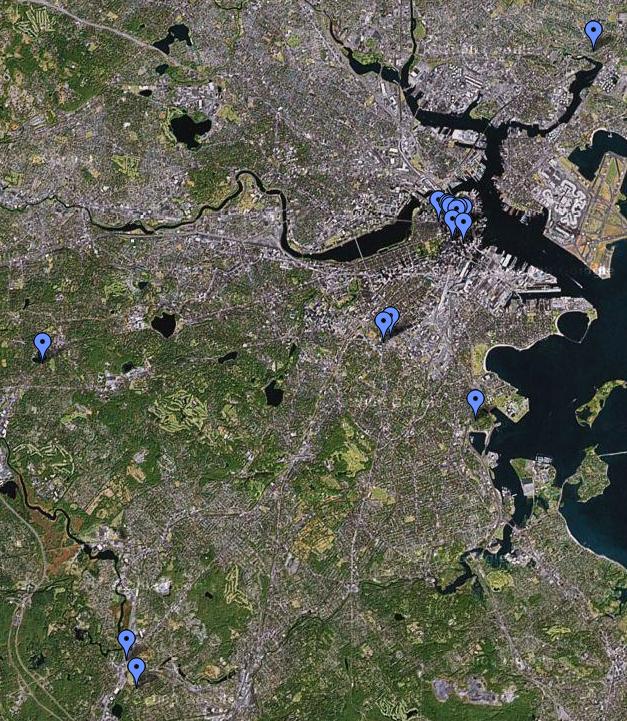We will include in this chapter what are now three neighborhoods of the city of Boston, although in the seventeenth century they were three distinct settlements. We also include Dedham, which was just to the south of Roxbury. In addition to the families described here, I need also mention four other Boston connections. Several sources claim GEORGE WOODWARD of Watertown married MARY GIBSON in Boston, but there is no evidence where the marriage took place nor where she lived prior to the marriage. Also REBECCA GIBSON was buried in the Eliot Burying Ground in Roxbury, as recorded by the Rev John Eliot, pastor of Roxbury First Church. There is no evidence that she ever lived in Roxbury. JOANNA (KEMBER) COFFIN, mother of TRISTRAM COFFIN of Newbury and Nantucket, died in Boston in 1661, a couple years after her son moved from Newbury to Nantucket. She may have moved to Boston soon after they arrived in the colony. SILAS WELCH of Bolton died in the army while stationed in Boston during the Revolutionary War. Finally, Rev EDWARD BULKELEY with his wife LUCIANN arrived in Boston in 1634, but we know nothing about his life here until he moved to Concord, and his story is in the Concord chapter.
|-Theodore Atkinson
????-|
|-Abigail Chambers
The Atkinson family is somewhat of a mystery. In the fourth generation, one of our ancestors living in Harvard, Massachusetts, married ELIZABETH ATKINSON of Groton in 1735. The marriage is recorded in the books of both Harvard and Groton. However there is no record of any Atkinson living in Groton before that time, and we don't know who are the parents of ELIZABETH. If we search through the records of New England, there are only three Atkinson's who are mentioned as emigrating during the 17th century. One of those three went to Plymouth Plantation, but had no children. The other two were brothers, THOMAS and THEODORE. THOMAS is described in the chapter on Concord, as he is one of our ancestors through one of his daughters. He had only one son, John, and we know about all of John's sons and grandchildren through his sons, and know that ELIZABETH was not one of his descendents. So by the process of elimination, ELIZABETH must have been a great-granddaughter of THEODORE ATKINSON, who had six sons. But there is only mention in the records of Boston about one of the sons, and the whereabouts of the other 5 sons and their sons are unknown. So we are faced with an unsettling gap in the ancestry of ELIZABETH. But even with this uncertainty, it is worth our while to look at THEODORE ATKINSON's life in Boston, because even if he is not ELIZABETH's ancestor, he is the brother of an ancestor, and he was the employee of another ancestor.
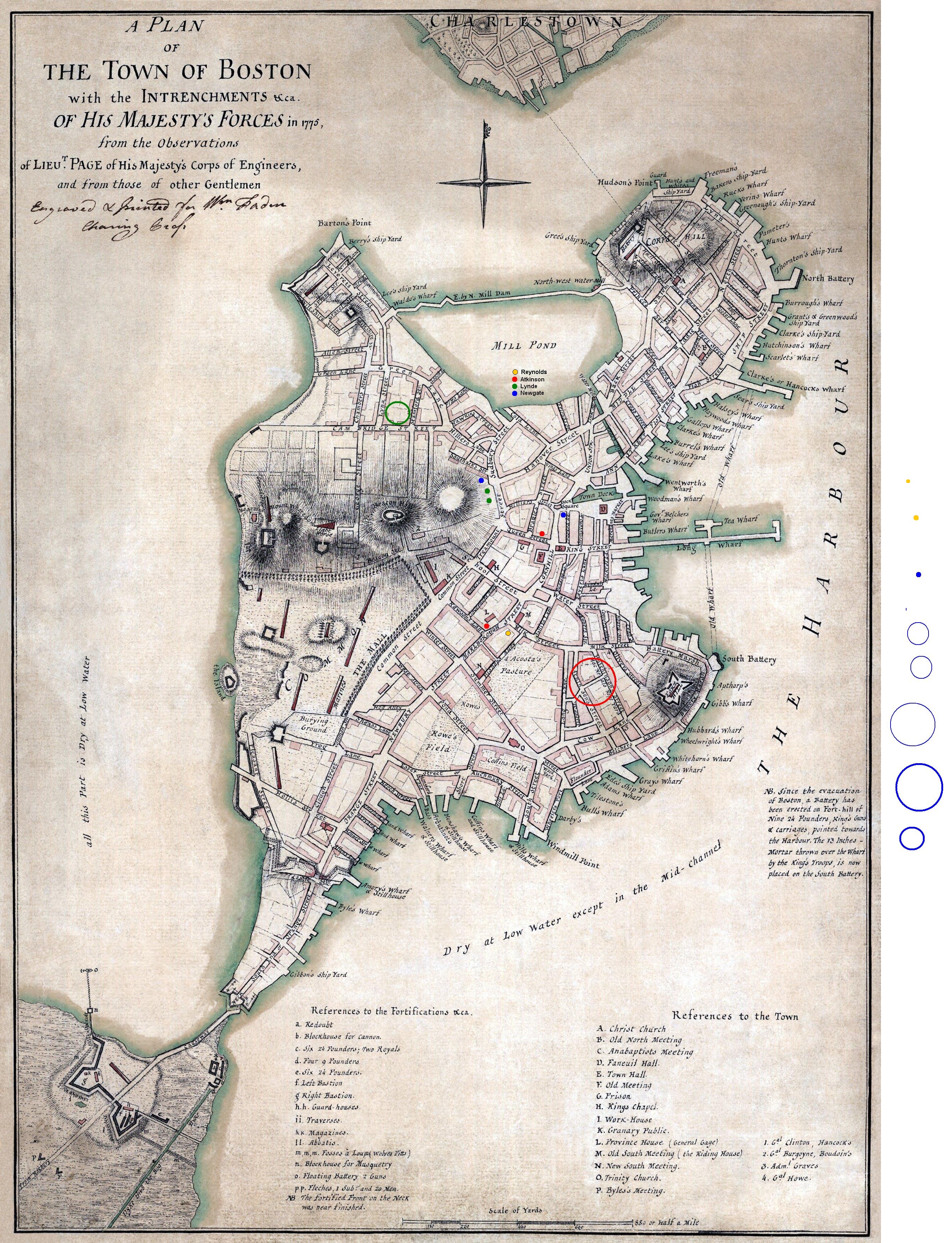 THEODORE came to Boston in 1634 and worked for our ancestor JOHN NEWGATE as a "felt maker". When he joined the church in Jan 1634/5 he was described as "Theodorus Atkinson, servant to our brother John Newgate". He became a freeman in 1642, joined the Military Company of the Massachusetts Bay in 1644/5, became constable in 1649, and clerk of the market in 1655. In 1669 he is listed as one of the founders of the Old South Church. He owned several pieces of land in Boston. In 1640 he received a grant of land at the Muddy River. In 1645 he bought a house on Court Street, on the second lot northwest from the corner of Washington St. This house was just a couple blocks from John Newgate's shop where he worked. In 1652 he bought another house on Washington St., near the present line of Bromfield Street, which was originally called Dawson St. after Edward Dawson, who THEODORE sold the house to in 1653/4. In 1662 he bought land from Edward Tyng at the south corner of Faneuil Hall Square and Merchants' Row, which he sold in 1690 to Henry Deering who started the Golden Ball Tavern there. Finally in 1667 he bought a seven acre pasture from Richard Fairbanks between High St and Milk St, east of the current Pearl St. Atkinson St was laid out through the pasture, and eventually renamed to Congress St.
THEODORE came to Boston in 1634 and worked for our ancestor JOHN NEWGATE as a "felt maker". When he joined the church in Jan 1634/5 he was described as "Theodorus Atkinson, servant to our brother John Newgate". He became a freeman in 1642, joined the Military Company of the Massachusetts Bay in 1644/5, became constable in 1649, and clerk of the market in 1655. In 1669 he is listed as one of the founders of the Old South Church. He owned several pieces of land in Boston. In 1640 he received a grant of land at the Muddy River. In 1645 he bought a house on Court Street, on the second lot northwest from the corner of Washington St. This house was just a couple blocks from John Newgate's shop where he worked. In 1652 he bought another house on Washington St., near the present line of Bromfield Street, which was originally called Dawson St. after Edward Dawson, who THEODORE sold the house to in 1653/4. In 1662 he bought land from Edward Tyng at the south corner of Faneuil Hall Square and Merchants' Row, which he sold in 1690 to Henry Deering who started the Golden Ball Tavern there. Finally in 1667 he bought a seven acre pasture from Richard Fairbanks between High St and Milk St, east of the current Pearl St. Atkinson St was laid out through the pasture, and eventually renamed to Congress St.
THEODORE married Abigail Chambers about 1640, and they had six children, including 4 sons, before she died. He then married Catherine Brinley and had two more sons. No further record is known about most of these sons, so we don't know which of the two wives might have been our ancestor. In addition to raising his own children, THEODORE also raised his nephew John, son of his brother THOMAS. John was about 10 years old when THOMAS died, and became an apprentice to THEODORE. He and his children all became "hatters". John moved to Newbury by 1664, and several generations of his offspring lived there.
|-Captain Edmund Greenleaf
|-Sarah Moore
EDMUND GREENLEAF married SARAH MOORE in 1611 and had 12 children, including STEPHEN, born about 1628, before the family emigrated to Newbury in 1635 (see the Newbury chapter). Around 1650 the family moved to Boston, where he was admitted as an inhabitant in 1654. In Boston he was a silk-dyer by trade, with his dyehouse by the spring. When SARAH died in 1663, he remarried Mrs. Sarah Hill, but had an unhappy marriage with her and her children. He died in 1670, and left a rather ordinary will
(Edmund Greenleaf will)
where he appointed his son STEPHEN and STEPHEN's father-in-law TRISTRAM COFFIN as executors of his estate, which had a value of £131.5.9. However he appended a very curious paper to the will explaining why he did not leave anything to his 2nd wife, which I am including here:
"When I married my wife, I kept her grandchild, as I best remember, three years to schooling, diet and apparel; and William Hill, her son, had a bond of six pounds a year, whereof I received no more than a barrel of pork of £3-0-0 of that £6-0-0 a year he was to pay me, and sent to her son Ignatius Hill, to the Barbadoes, in mackerel, cider, and bread and pease, as much as come to twenty pounds, and never received one penny of it. His aunt gave to the three brothers £50 apiece. I know not whether they received it or no; but I have not received any part of it."
"Witness my hand. (Signed) Edmund Greenleaf."
"Besides, when I married my wife, she brought me a silver bowl, a silver porringer, and a silver spoon. She lent or gave them to her son, James Hill, without my consent."
|-Stephen Iggleden
Ruth Iggleden-|
Sarah Iggleden-|
|-Elizabeth Bennett
STEPHEN and ELIZABETH IGGLEDEN and at least five children including RUTH and SARAH left England on the ship "Castle" in 1638. Sadly, STEPHEN died on the ship. The rest of the family settled in Roxbury (originally called Rocks borough), where "Widow Iggulden" owned 22 acres, became a proprietor, married Joseph Patcham and had two more sons. Joseph removed to Fairfield, Connecticut, with one of his sons around 1658, but ELIZABETH appears to have remained in Roxbury where she died about 1681. SARAH married JOHN NUTTING in Woburn in 1650 while RUTH married SAMUEL BLODGETT in Woburn on Dec 13, 1655.
|-John Kent
|
|-Hannah Griswold
JOHN KENT first came to Dedham in 1645 with his two brothers. He was admitted to the Dedham church in 1652 and became a freeman in 1654. He was on the tax lists in Dedham from 1653 to 1664. He married HANNAH GRISWOLD in 1662, and she joined the Dedham church in 1664. In 1667 they moved to Charlestown where all of their nine children were born, including EBENEZER in 1680. EBENEZER eventually moved to Hingham around 1703 (see the Hingham chapter), while JOHN and HANNAH both died in Charlestown in the 1690s.
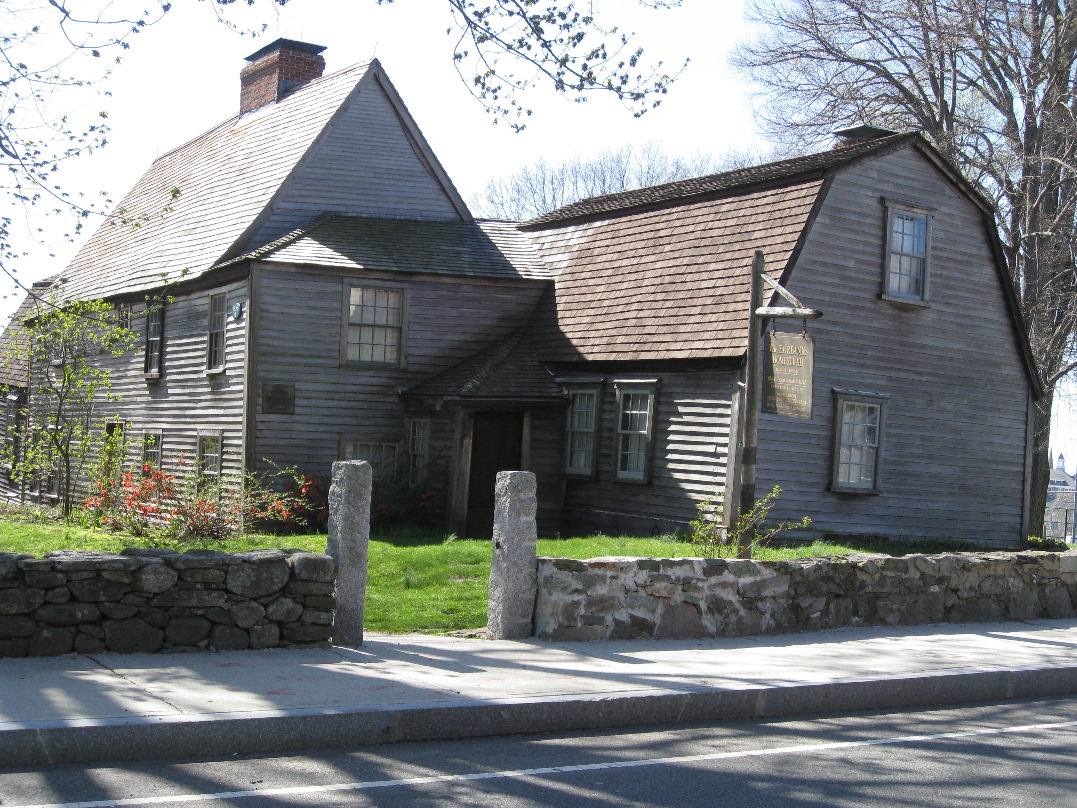
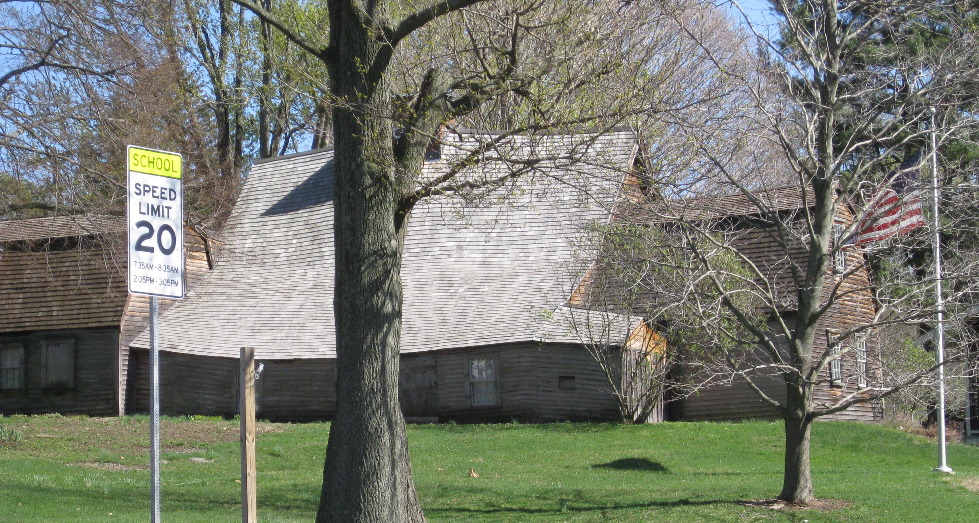
|-Simon Lynde
Nathaniel Lynde-| |-John Newgate
|-Hannah Newgate-|
|-Ann
The Newgate family was the third of our ancestors to emigrate to New England, preceded only by the Lyford family (see Hingham chapter) and Edward Johnson (see Charlestown chapter). JOHN and ANN NEWGATE came from Southwark, England, and were a resident of Boston in 1633. He was called a "hatter", or "haberdash of hatts", or a merchant. ANN was listed in the records as being admitted to the church in 1633, while JOHN was listed in 1634 and THEODORUS ATKINSON, a servant to JOHN, in 1635. John was a freeman in 1634/5, a Constable in 1636, on a committee to oversee allotments in 1636, selectman in 1636, 1638, and 1640, and a Deputy to the General Court in 1638. The Newgate family lived in a house southeast of Tremont Hill, on the south side of what is now Cambridge St near Somerset St. JOHN was also alloted 112 acres at Rumley Marsh and Pullen Point in 1638, and the following year he bought an additional 150 acres bordering his property. This land became known as the Newgate, the Shrimpton, then Yeamans farm. The farm-house of the estate stood on Mill St. in Revere, and the farm stretched from the tide water at what used to be Slade's Mill, north to include the hill east of Woodlawn Cemetery. There was a "Newgate landing" on the Creek. Old history books show a photograph of the farm-house built in 1680 by JOHN's son Nathaniel. In 1640, JOHN gave Harvard College "five pounds per annum for ever..." to be paid from the rents of his farm at Rumney Marsh. The Newgate's had six children. The last, HANNAH NEWGATE, was born in Boston in June 28, 1635, and was our first ancestor born in New England.
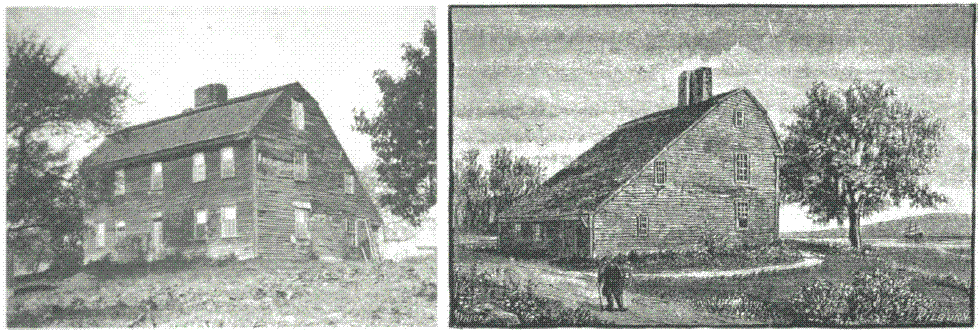
House built about 1680 by John Newgate's son Nathaniel on John Newgate's 262 acre farm in the current town of Revere.
SIMON LYNDE grew up apprenticed to Mr. Delaney, a merchant of London. He first went to Holland to learn the trade, followed by coming to Boston in 1650. Within the year he became betrothed to HANNAH NEWGATE. He returned to England for a brief visit, then came back and married HANNAH on Feb 22, 1652/3. He became very successful and acquired large land possissions in Massachusetts, Connecticut, and Rhode Island. He was elected constable in 1658, appointed one of the Assistant Justices of the Court of Pleas and Sessions in 1886, and appointed one of the Justices Assistant of the Superior Court in 1687. He lived in a house built by his father-in-law adjacent to the Newgate house. In 1663 he also bought the house adjacent to the south, called "The Spring House", and a two acre plot on the north side of what is now Cambridge St to the west of the Old West Church ("Lynde St." is a dead-end street a couple hundred feet west of the church). When the Newgates died, JOHN and HANNAH inherited both houses, so they now owned three houses in a row, about three acres. These three houses were at the beginning of Tremont St., and included most of the curve of modern Cambridge St. between Bowdoin St and Court St. In 1708, "Tra Mount St" was defined as "...the way leading from the Mansion house of ye Late Simon Lynde Esq by Cap Southjacks, extending as far as Col Townsends corner".
JOHN and HANNAH had 12 children, including NATHANIEL LYNDE, born in 1659. NATHANIEL grew up as an apprentice to his father in Boston. In 1683 he married SUSANNAH WILLOUGHBY of Charlestown, and the couple moved to Saybrook, Connecticut, where he possessed several hundred acres of land deeded to him from his father in 1685. (Read more about them in the Connecticut chapter.)
|-Robert Reynolds
Ruth Reynolds-|
|-Mary
ROBERT and MARY REYNOLDS and their four children immigrated to Boston on the Winthrop Fleet of 1630; their fifth child was born on the ship or shortly after in America. Robert was admitted to the church and became a freeman in 1634, while MARY was admitted to the church in 1645. ROBERT was a successful shoemaker. He bought his home lot around 1640, at the southeast corner of what are now Washington and Milk Streets, on the site of the modern Transcript Building. He also owned land at Muddy River and Long Island. When he died in 1659, he gave his lands and estate to MARY with the provision that when she died it would be given to his only son Nathaniel, who was a ship captain in Rhode Island. He also gave 20 pounds to each of his four daughters, including daughter RUTH WHITNEY. The inventory of the estate included 110 pounds for his house. When Nathaniel inherited the house and land, he never lived there, but rented out the several buildings on the land. In 1685 Josiah Franklin became one of his tenants in a small house wedged between larger homes. Benjamin Franklin was born there in 1705.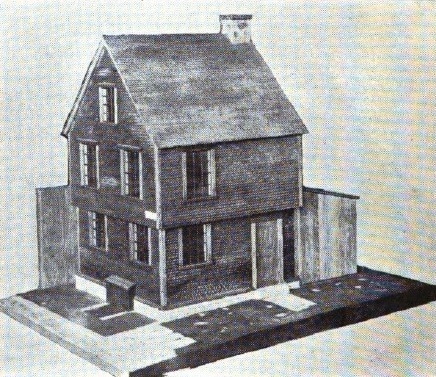
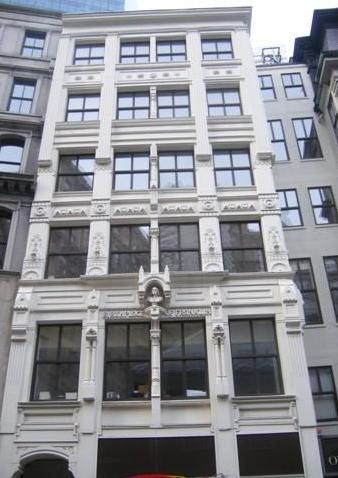
A model of the house where Benjamin Franklin was born, and the building now there at 1 Milk St (note Ben's bust above the 2nd floor)
|-Thomas Wiswall
Ester Wiswall-|
|-Elizabeth Barbage
THOMAS WISWALL and ELIZABETH BARBAGE married in England in 1632, and after one child was born emigrated with his brother's family to Dorchester in 1635. There they had seven more children including ESTHER born in 1635. They joined the first church in Dorchester August 23, 1636. THOMAS subscribed to the school fund in 1641, was voted a selectman in 1642, 1644, and 1652, and became a freeman in 1652. He had over 5 acres of land by 1637 including 2 acres towards Fox Point (Savin Hill). In 1645 he bought another 3 1/2 acres from Thomas Clarke, and in 1646 bought all the lots in Dorchester of Richard Williams. Their son Ichabod, by agreement between the Selectmen, THOMAS, and Ichabod, and with the consent of Thomas, became the first public school teacher in Dorchester in 1656.
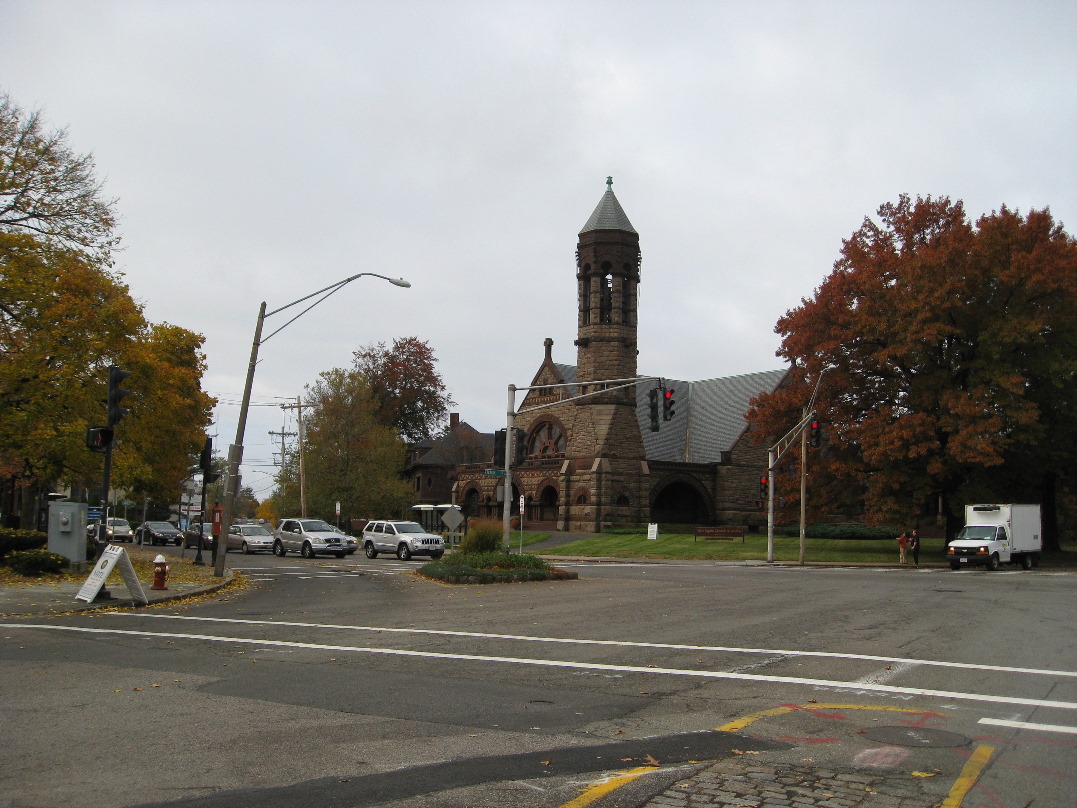
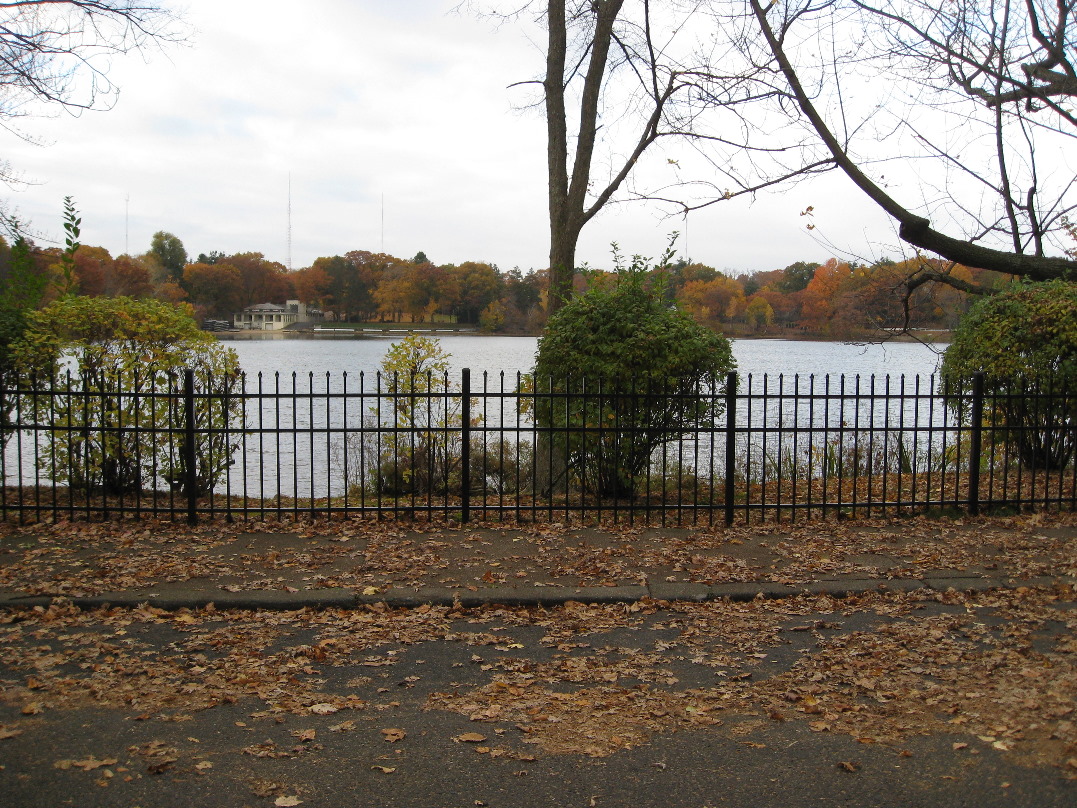
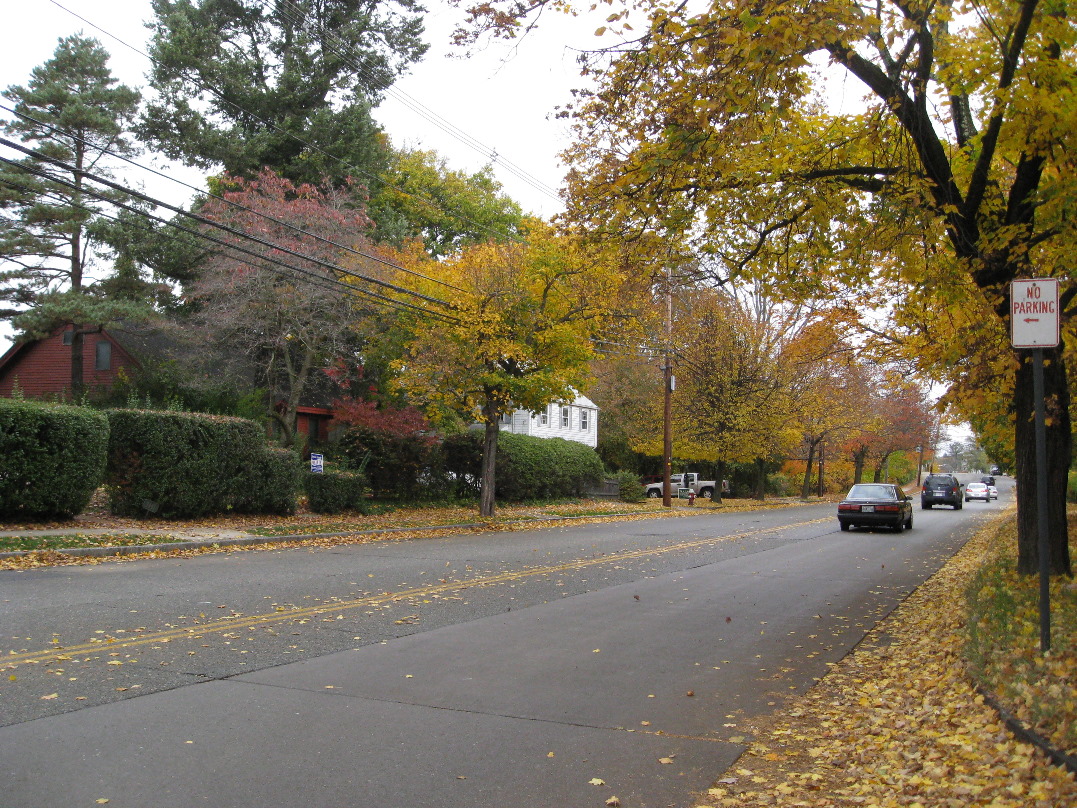
400 acre Wiswall estate in Cambridge Village (Newton) including Wiswall Pond (Crystal Lake). Their home was on Centre Street, south of the pond. The photo on the left shows a church on Centre St on the northeast part of the property while the photo on the right is looking north on Centre Street where their house would have been.
In 1654 the family moved to Cambridge Village, a part of Cambridge that split off in 1688 to become the current Newton. They were one of the first 20 families to live there, and are honored as one of three families mentioned on the First Settlers Monument in the Old East Parish Burying Ground in Newton. THOMAS acquired 400 acres including what was then called Wiswall Pond, now called Crystal Lake in Newton Highlands. Their house was on the south bank of the pond on Centre St. He became active in the affairs of the community, and his name comes up frequently in the records. In 1656 he was appointed to survey the highways of Cambridge for the next year, along with ABRAHAM ERRINGTON. Also in 1656 he signed a petition for release from supporting the church at Cambridge, which led eventually to the formation of a Cambridge Village Church. He was selected as the ruling elder of the church on July 20, 1664, and acted as assistant pastor to Rev John Eliot Jr. In 1656 and in 1663 he served on a grand jury at Cambridge. In October 1663 he was released from all ordinary military training, paying 5 shillings each year to the military company. On June 17, 1673 he was summoned to the General Court to answer for "breach of the law by putting in a double vote for one man, in the election of magistrate". He failed to appear, and was summoned again to the next Court at Cambridge. ELIZABETH died in the late 1660s, and THOMAS married the widow Isabelle Farmer. He died in 1683 in Cambridge Village. His estate in the village was £340. He had already given all of his land in Dorchester to his son Enoch (Thomas Wiswall estate). Some of the Wiswall children are buried in the Dorchester North Burying Ground, while THOMAS is buried at the East Parish Burying Ground, also called Centre St. Cemetery, at Centre & Cotton Sts. in Newton. Daughter ESTHER married WILLIAM JOHNSON of Woburn in 1655 and lived in Woburn.
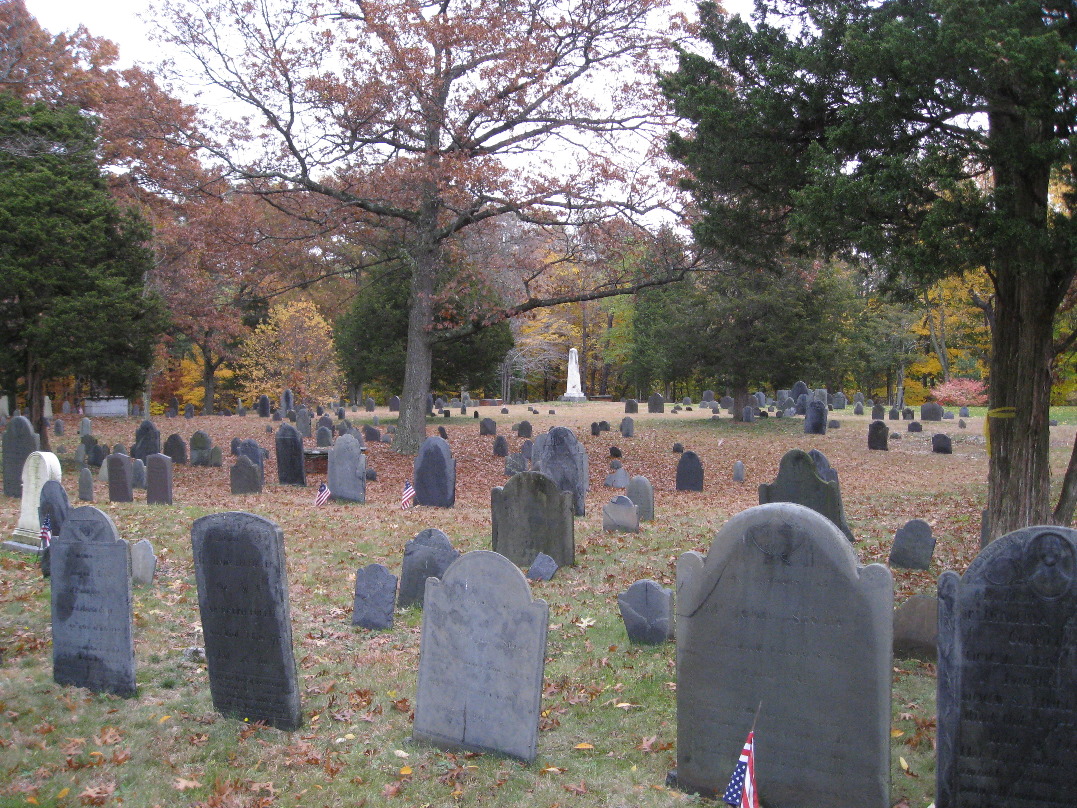
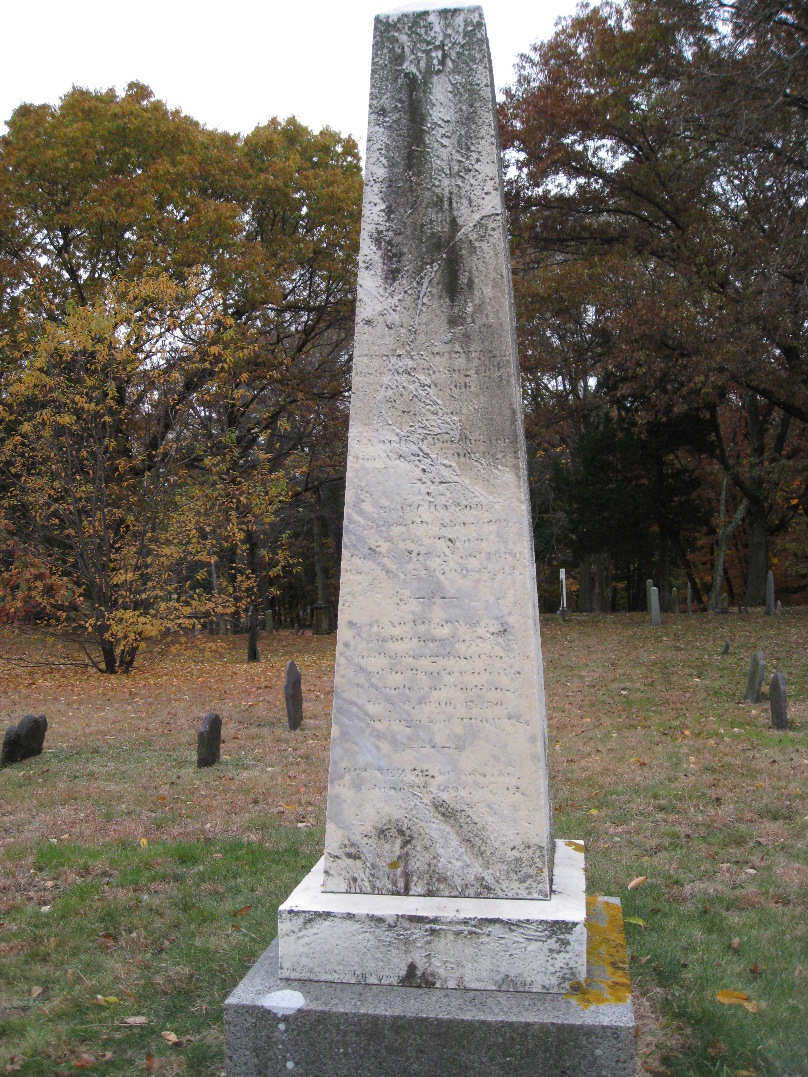
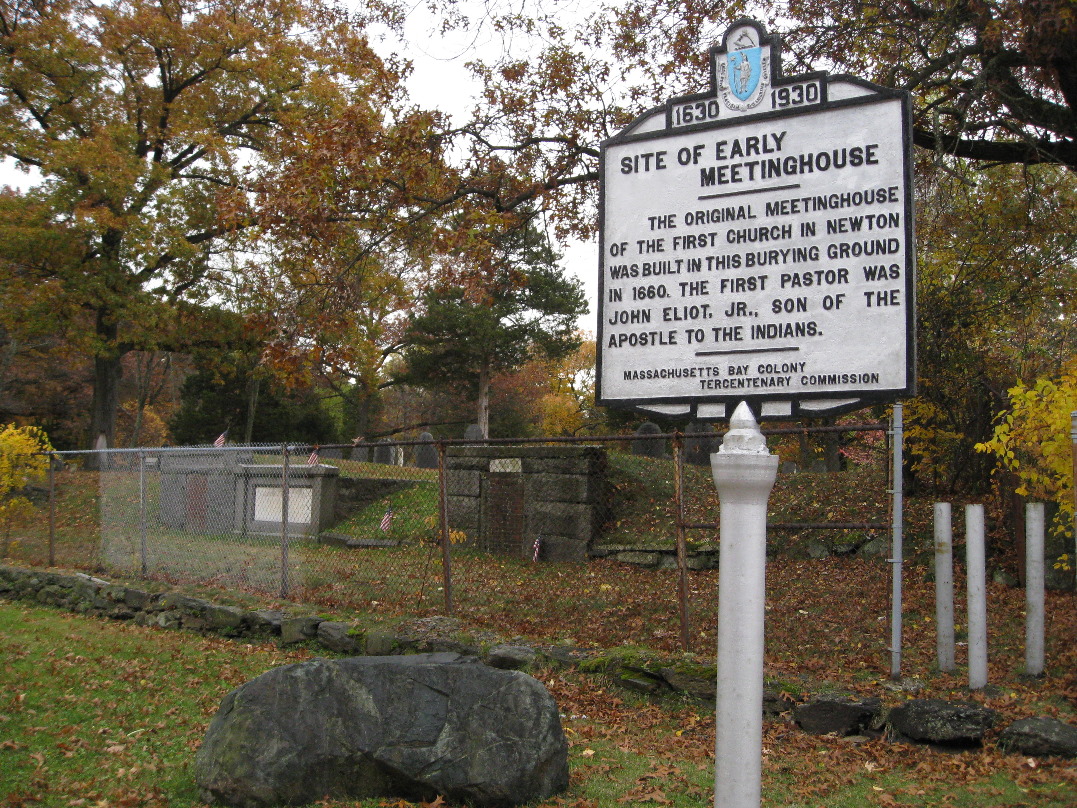
Thomas Wiswall, ordained ruling elder July 20, 1664. His son ENOCH of Dorchester Died Nov. 28, 1706, aet. 73. --- Rev. ICHABOD, minister of Duxbury, 30 yrs, Agent of Plymouth Colony in England, 1690. Died July 23, 1700, aet. 63. --- Capt. NOAH, of Newton, an officer in the expedition against Canada, killed in battle with the French and Indians July 6, 1690, aet. 50, leaving a son Thomas. --- EBENEZER of Newton died June 21, 1691, aet. 45.
Bibliography (all of these books can be downloaded and read from Google Books):
- "The Memorial History of Boston, including Suffolk County, Massachusetts" by Justin Winsor, 1885 (especially volumes I and II)
- "A history of the early settlement of Newton, county of Middlesex, from 1639 to 1800" by Francis Jackson, 1854
- "King's Handbook of Newton Massachusetts" by M. F. Sweetser, 1889
- "Vital Records of Newton, Massachusetts, to the year 1850", New England Historic Genealogical Society, 1905
